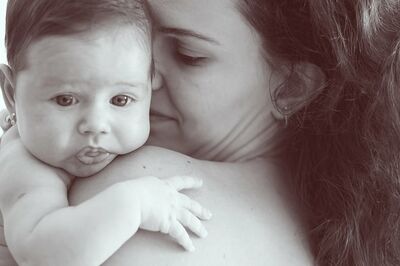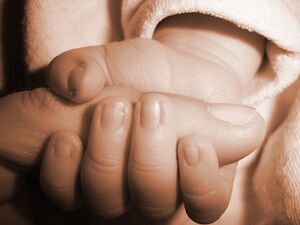Understanding Newborn Behaviour: Difference between revisions
No edit summary |
m (moved para) |
||
| Line 39: | Line 39: | ||
=== States of arousal === | === States of arousal === | ||
Throughout the day, an infant will cycle through these stages, some quick others slow. American paediatrician Dr. T.B. Brazelton identified six states of infants behaviours. Healthchildren.org<ref name=":3">https://www.healthychildren.org/English/ages-stages/baby/Pages/States-of-Consciousness-in-Newborns.aspx</ref> describes Dr. Brazelton’s six stages of arousal: | |||
# '''Deep Sleep State''': Completely relaxed, unresponsive to outside noise, and breathing deeply. | # '''Deep Sleep State''': Completely relaxed, unresponsive to outside noise, and breathing deeply. | ||
| Line 49: | Line 49: | ||
=== Body Language and Cues === | === Body Language and Cues === | ||
Understanding an infant’s communication and language can be done successfully by observation. Attending to a newborn’s needs of social interaction, sleep or feeding can be done by learning the differing behavioural states/stages. Raising Children<ref>https://raisingchildren.net.au/newborns/connecting-communicating/communicating/baby-cues</ref> has created videos demonstrating the following cues infants convey. | |||
==== Tired ==== | ==== Tired ==== | ||
Revision as of 01:19, 9 December 2021
Introduction[edit | edit source]
Newborns are born with an innate capacity to interact with their environment.[1] (speaker) Instinctive cognitive and sensorimotor behaviour contribute to survival and social bonding.[2] Infants naturally find ways to use touch, manage arousal levels, self-soothe and adapt to their new physical environment. In addition to adaptation, they signal their needs with different cries and temperaments. [1]
Adapting to the Environment[edit | edit source]
One of the most effective ways for an infant to adapt to their environment is through skin-to-skin contact (baby on their mother’s chest).[3] UNICEF[4] outlines the many benefits for mother-infant skin-to-skin contact:
- “Calms and relaxes both mother and infant
- Regulates the infant’s heart rate and breathing, helping them to better adapt to life outside the womb
- Stimulates digestion and interest in feeding
- Regulates temperature
- Enables colonization of the infant’s skin with the mother’s friendly bacteria, thus providing protection against infection
- Stimulates the release of hormones to support breastfeeding and mothering”[4]
Research shows skin-to-skin contact may have secondary benefits on the mother’s long term mental health in addition to infant development. [5][6]
Reflexes vs. Actions[edit | edit source]
Reflexes in infancy refer to synergistic movements that serve a purpose, are predictable and do not adjust to various conditions. Rooting, sucking, stepping, reaching and grasping are movements that have been referred to as normal infant reflexes. Recent evidence shows that these particular synergies involve complex movements that are goal-oriented and adaptable to ongoing changes in the environment questioning that they are deliberate actions versus a reflex.[2][1]
Rooting[edit | edit source]
Rooting refers to stimulation around the infant's mouth whereby the infant move towards that provocation. The motion of the infant's head and mouth occurs simultaneously with whole-body movements suggesting rooting is more than a reflex.[2]
Sucking[edit | edit source]
Sucking is another newborn behaviour that involves a complex interaction of muscle contractions that is adaptable to the environment. Babies adjust sucking pressure based on the flow of milk by sensing the upcoming flow. Studies show that newborns adjust the sucking pressure in a precise and anticipatory way demonstrating action vs. reflex.[2] Sucking adaptation can also be seen when newborns suck for comfort instead of food.[7]
Stepping[edit | edit source]
The stepping reflex has been described as steps an infant takes when they are lowered to a surface from an upright underarm supported position. Studies are now showing that infants adjust the number of steps based on the visual field beneath them. When the infants feel they are standing and moving forward they take more steps than when they perceive they are just standing in an upright position.[2]
Reaching and Grasping[edit | edit source]
Reaching and grasping for objects are behaviours that can be action-oriented rather than reflexive. Infants demonstrate the ability to control upper extremity movement in the direction of a visual target and proprioceptively grasp an object. This type of motor behavior illustrates goal-oriented behaviour where the infant is adapting to their environment.[2]
States of arousal[edit | edit source]
Throughout the day, an infant will cycle through these stages, some quick others slow. American paediatrician Dr. T.B. Brazelton identified six states of infants behaviours. Healthchildren.org[8] describes Dr. Brazelton’s six stages of arousal:
- Deep Sleep State: Completely relaxed, unresponsive to outside noise, and breathing deeply.
- Active Sleep State: Rotating or fluttering of the eyes, shallow breathing, more receptive to outside noise.
- Drowsy State: State between alertness and sleepiness. Light stimulation, such as rocking them, can help ease them into sleep or slowly wake them up.
- Quiet Alert State: Ideal time for learning. They’re happy, peaceful, and focused. Ready for stimulation and interaction.
- Active Alert State: Stretching, kicking, and rotating arms. Often referred to as “fussy” period.
- Crying State: Flailing, screaming, kicking are all expressions of discomfort, such as hunger, boredom, loneliness, or tiredness. This is a time to soothe, provide resources, and a sense of safety. [8]
Body Language and Cues[edit | edit source]
Understanding an infant’s communication and language can be done successfully by observation. Attending to a newborn’s needs of social interaction, sleep or feeding can be done by learning the differing behavioural states/stages. Raising Children[9] has created videos demonstrating the following cues infants convey.
Tired[edit | edit source]
- Yawns
- Fusses
- Losing interest in people or toys
- Starring into the distance
- Jerky movements
- Sucking fingers
Hungry[edit | edit source]
- Head turn towards breast
- makes sucking noises
Play[edit | edit source]
- Smiles
- Hands reaching towards you
- Eyes wide and bright
- Eye contact with you
- Smooth movements
Need a Break[edit | edit source]
- Squirms
- Kicks
- Turn head away from you
Infant Temperament:[edit | edit source]
Newborn temperament describes the way in which babies respond and react to stimulation. Their emotions and reactions are a result of nature (innate personality) and nurture (parenting style). Researchers Thomas and Chess reported that when personality is well suited to their environment, children will do better than children whose personalities and environments fit together poorly. [10] Personality traits can be categorized into the following nine categories: [1]
- Activity level: how active the infant is
- Rhythmicity: how regular the infant’s sleep/wake and feeding routines are
- Distractibility: how easily the infant can be distracted from something they are doing
- Approach/withdrawal: how the infant responds to new experiences
- Adaptability: how the infant adapts to new situations
- Attention span/persistence: how persistent the infant is when faced with challenges
- Intensity of reaction: how intense the infant’s responses and emotions are
- Sensitivity: how sensitive the infant is to flavours, textures, and noises
- Quality of mood: whether the infant has a happy, positive mood most of the time or an unpleasant, negative mood most of the time [1]
Based on these personality traits, Dr. Thomas and Chess then divided babies into three temperament categories.
- Easy or flexible: adaptable, not easily upset, happy, regular sleep and eating patterns
- Active or feisty: fearful of new people or situations, easily upset by stimulation or noise, fussy, intense in reactions
- Slow to warm or cautious: withdraw or react negatively to new situations, but over time become more positive with repeated exposure, less active
Not all babies fit into a category. 40% are easy, 10% are active, 15% slow to warm up. The basic temperament trait remains the same over time, but the intensity to the trait may change.[11]
Understanding the baby’s temperament is an important aspect for early interventionists.
Resources[edit | edit source]
- https://www.childrenshospital.org/research/centers-departmental-programs/brazelton-institute https://skillsforaction.com/highly-sensitive-child https://www.marchofdimes.org/complications/learning-your-baby-s-cues.aspx https://raisingchildren.net.au/newborns/connecting-communicating/communicating/baby-cues https://www.unicef.org.uk/babyfriendly/baby-friendly-resources/implementing-standards-resources/skin-to-skin-contact/
References[edit | edit source]
- ↑ 1.0 1.1 1.2 1.3 1.4 Versfeld, P. Understanding Newborn Behaviour, Physioplus.2022
- ↑ 2.0 2.1 2.2 2.3 2.4 2.5 Von Hofsten C, Rosander K. The development of sensorimotor intelligence in infants. Advances in child development and behavior. 2018 Jan 1;55:73-106.
- ↑ Cleveland L, Hill CM, Pulse WS, DiCioccio HC, Field T, White-Traut R. Systematic review of skin-to-skin care for full-term, healthy newborns. Journal of Obstetric, Gynecologic & Neonatal Nursing. 2017 Nov 1;46(6):857-69.
- ↑ 4.0 4.1 https://www.unicef.org.uk/babyfriendly/baby-friendly-resources/implementing-standards-resources/skin-to-skin-contact/
- ↑ Bigelow AE, Power M. Mother–Infant Skin-to-Skin Contact: Short‐and Long-Term Effects for Mothers and Their Children Born Full-Term. Frontiers in Psychology. 2020;11
- ↑ Cooijmans KH, Beijers R, Rovers AC, de Weerth C. Effectiveness of skin-to-skin contact versus care-as-usual in mothers and their full-term infants: study protocol for a parallel-group randomized controlled trial. BMC pediatrics. 2017 Dec;17(1):1-6.
- ↑ Lau C. Development of suck and swallow mechanisms in infants. Annals of Nutrition and Metabolism. 2015;66(Suppl. 5):7-14.
- ↑ 8.0 8.1 https://www.healthychildren.org/English/ages-stages/baby/Pages/States-of-Consciousness-in-Newborns.aspx
- ↑ https://raisingchildren.net.au/newborns/connecting-communicating/communicating/baby-cues
- ↑ McClowry SG, Rodriguez ET, Koslowitz R. Temperament-based intervention: Re-examining goodness of fit. International Journal of Developmental Science. 2008 Jan 1;2(1-2):120-35.
- ↑ http://csefel.vanderbilt.edu/resources/wwb/wwb23.html









